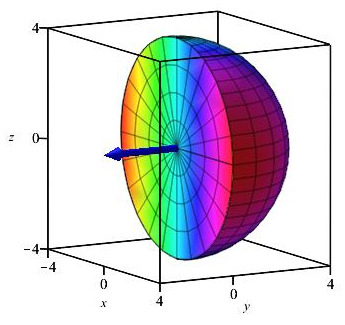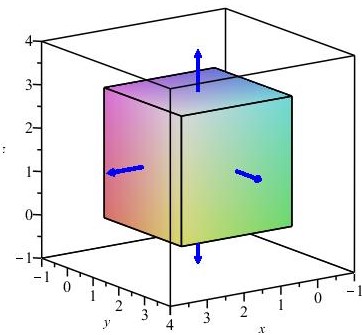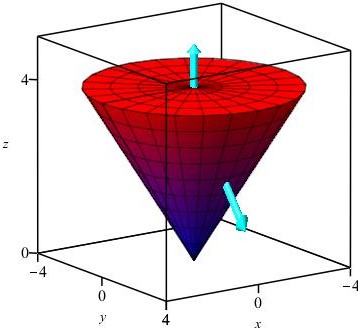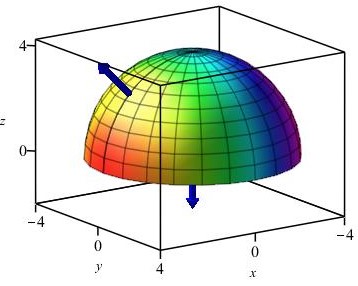12. Gauss' Theorem
Let \(V\) be a nice solid region in \(\mathbb{R}^3\) with a nice properly oriented boundary, \(\partial V\), and let \(\vec F\) be a nice vector field on \(V\). Then \[ \iiint_V \vec\nabla\cdot\vec F\,dV =\iint_{\partial V} \vec F\cdot d\vec S \] The outer boundary must be oriented outward while any inner boundaries must be oriented inward. This means that all pieces of the boundary are oriented away from the solid.
Exercises
-
Consider the volume integral \(\displaystyle \iiint_{H}\vec{\nabla}\cdot\vec{F}\,dV\) over a hemisphere of radius of \(4\) to the right of \(y=0\) where \(0 \le \theta \le \pi\) and \(\vec{F}=\left\langle 0,\dfrac{y}{4},0\right\rangle\).

-
Express the volume integral as two surface integrals using Gauss' Theorem
\(\begin{aligned} \iiint_{H}\vec{\nabla}\cdot \vec{F}\ dV &=\iint_{\text{hemi}}\vec{F}\cdot d\vec{S} +\iint_{\text{disk}}\vec{F}\cdot d\vec{S} \\ \end{aligned}\)
Gauss' Theorem tells us that the volume integral can be computed as the surface integral over the boundary. Here the boundary consists of two surfaces:
(1) the hemisphere of \(\rho=4\) with \(y \ge 0\) which may be parameterized by \[ R_{\text{hemi}}\left(\theta,\phi\right) =\left(4\sin\phi\cos\theta,4\sin\phi\sin\theta,4\cos\phi\right) \] for \(0 \le \phi \le \pi\) and \(0 \le \theta \le \pi\) and
(2) the disk in the plane \(y=0\) which may be parameterized by \[ R_{\text{disk}}\left(r,\theta\right) =\left(r\cos\theta,0,r\sin\theta\right) \] for \(0 \le r \le 4\) and \(0 \le \theta \le 2\pi\). So the volume integral becomes: \[\begin{aligned} \iiint_{H}\vec{\nabla}\cdot \vec{F}\ dV &=\iint_{\text{hemi}}\vec{F}\cdot d\vec{S} +\iint_{\text{disk}}\vec{F}\cdot d\vec{S} \\ \end{aligned}\] -
Compute each surface integral and the total boundary integral.
\(\begin{aligned} \iint_{\text{hemi}}\vec{F}\cdot d\vec{S} &=\dfrac{32}{3}\pi \\ \iint_{\text{disk}}\vec{F}\cdot d\vec{S} &=0 \end{aligned}\)
\(\begin{aligned} \iiint_{H} &\vec{\nabla}\cdot \vec{F}\ dV =\iint_{\partial H}\vec{F}\cdot d\vec{S} \\ &=\iint_{\text{hemi}}\vec{F}\cdot d\vec{S} + \iint_{\text{disk}}\vec{F}\cdot d\vec{S} =\dfrac{32}{3}\pi \end{aligned}\)Hemisphere: The hemisphere is \[ R_{\text{hemi}}\left(\theta,\phi\right) =\left(4\sin\phi\cos\theta,4\sin\phi\sin\theta,4\cos\phi\right) \] for \(0 \le \phi \le \pi\) and \(0 \le \theta \le \pi\). The normal is: \[\begin{aligned} \vec{N}&=\vec{e}_{\phi }\times \vec{e}_{\theta }= \begin{vmatrix} \hat \imath & \hat \jmath & \hat k \\ 4\cos\phi \cos\theta & 4\cos\phi \sin\theta & -4\sin\phi \\ -4\sin\phi \sin\theta & 4\sin\phi \cos\theta & 0 \end{vmatrix} \\ &=\hat \imath\left(16\sin^{2}\phi\cos\theta\right) -\hat \jmath\left(-16\sin^{2}\phi\sin\theta\right) \\ &\quad+\hat k\left(16\sin\phi\cos\phi\cos^{2}\theta +16\sin\phi\cos\phi\sin^{2}\theta \right) \\ &=\left\langle 16\sin^{2}\phi\cos\theta,16\sin^{2}\phi\sin\theta, 16\sin\phi\cos\phi\right\rangle \end{aligned}\] This is correctly oriented outward. On the hemisphere, the vector field, \(\vec{F}=\left\langle 0,\dfrac{y}{4},0\right\rangle\), becomes \[ \vec{F}=\left\langle 0,\sin\phi\sin\theta,0\right\rangle \] Now we can compute the dot product: \[ \vec{F}\cdot\vec{N} =16\sin ^{3}\phi \sin ^{2}\theta \] and the surface integral \[\begin{aligned} \int_{\text{hemi}}\vec{F}\cdot d\vec{S} &=16\int_{0}^{\pi}\int_{0}^{\pi}\sin^{3}\phi\sin^{2}\theta\,d\theta\,d\phi \\ &=16\int_{0}^{\pi}(1-\cos^2\phi)\sin\phi\,d\phi \int_{0}^{\pi}\dfrac{1-\cos2\theta}{2}\,d\theta \\ &=16\left[-\cos\phi+\dfrac{\cos^3\phi}{3}\right]_{0}^{\pi} \left[\dfrac{1}{2}\left(\theta-\dfrac{\sin2\theta}{2}\right)\right]_{0}^{\pi} \\ &=16\cdot2\left(1-\dfrac{1}{3}\right)\dfrac{\pi}{2} =\dfrac{32}{3}\pi \end{aligned}\]
Disk: On the disk at \(y=0\), the vector field, \(\vec{F}=\left\langle 0,\dfrac{y}{4},0\right\rangle\) becomes \(\vec{F}=\langle 0,0,0\rangle\). So the integral is zero: \[ \iint_{\text{disk}} \vec{F}\cdot d\vec{S}=0 \]
Total: Adding the hemisphere and disk integrals, our total surface integral is: \[\begin{aligned} \iiint_{H} &\vec{\nabla}\cdot\vec{F}\,dV =\iint_{\partial H}\vec{F}\cdot d\vec{S} \\ &=\iint_{\text{hemi}}\vec{F}\cdot d\vec{S} + \iint_{\text{disk}}\vec{F}\cdot d\vec{S} =\dfrac{32}{3}\pi \end{aligned}\]
-
Compute \(\vec{\nabla}\cdot\vec{F}\) and the volume integral directly. Did Gauss' Theorem help to simplify the problem?
Always compute a divergence or curl in rectangular coordinates! Then convert it to the coordinates needed for the integral.
\(\displaystyle \iiint_{H} \vec{\nabla}\cdot\vec{F}\,dV= \dfrac{32}{3}\pi \)
No, Gauss' Theorem did not simplify this problem because it is easier to compute the divergence of \(\vec{F}\) and a volume integral.The divergence is \(\vec{\nabla}\cdot\vec{F}=0+\dfrac{1}{4}+0=\dfrac{1}{4}\). So the volume integral is: \[\begin{aligned} \iiint\limits_{H} &\vec{\nabla}\cdot\vec{F}\,dV =\int_{0}^{\pi}\int_{0}^{\pi}\int_{0}^{4} \dfrac{1}{4}\rho^{2}\sin\phi\,d\rho\,d\phi\,d\theta \\ &=\dfrac{1}{4}(\text{Volume of hemisphere}) =\dfrac{1}{4}\cdot\dfrac{1}{2}\cdot\dfrac{4}{3}\pi4^3 =\dfrac{32}{3}\pi \end{aligned}\] No, the volume integral was much easier than the surface integrals.
-
-
Compute the surface integral \(\displaystyle \iint_{\partial C} \vec{F}\cdot d\vec{S}\) where \(\vec{F}=\langle y,3y^{2},x^{2}z\rangle\) over the cube, \(0 \le x \le 3\), \(0 \le y \le 3\), \(0 \le z \le 3\), oriented outward, by using Gauss' Theorem to simplify the problem.

\(\displaystyle \iint_{\partial C} \vec{F}\cdot d\vec{S} =\iiint_{C} \vec{\nabla}\cdot\vec{F}\,dV =324\)
The problem can be simplified from 6 surface integrals to one volume integral by Gauss' Theorem: \[ \iint_{\partial C} \vec{F}\cdot d\vec{S} =\iiint_{C} \vec{\nabla}\cdot\vec{F}\,dV \] The divergence of \(\vec{F}=\langle y,3y^{2},x^{2}z\rangle\) is \(\vec{\nabla}\cdot\vec{F}=0+6y+x^2\). The volume differential is: \(dV=dx\,dy\,dz\).
Thus the integral is: \[\begin{aligned} \int_{0}^{3}\int_{0}^{3}\int_{0}^{3} (6y+x^2)\,dx\,dy\,dz &=3\int_{0}^{3} \left[6xy+\dfrac{x^3}{3}\right]_{x=0}^{3}dy \\ &=3\int_{0}^{3} (18y+9)\,dy \\ &=3\left[9y^2+9y\right]_{0}^{3} \\ &=3\left( 81+27\right) =324 \end{aligned}\]cj
-
Verify Gauss' Theorem \(\displaystyle \iiint_C \vec\nabla\cdot\vec F\,dV =\iint_{\partial C} \vec F\cdot d\vec S\) for the vector field \(\vec{F}=\left\langle yz^{2},xz^{2},z\left( x^{2}+y^{2}\right) \right\rangle\) and the solid cone \(\sqrt{x^{2}+y^{2}}\leq z\leq 4\).

-
LHS: Volume Integral: Compute the divergence in rectangular coordinates. Then choose a coordinate system for the integral, and express the divergence and \(dV\) in those coordinates.
\(\displaystyle \iiint_C \vec\nabla\cdot\vec F\,dV = \dfrac{512\pi }{5}\)
On the left hand side, we first compute the divergence \(\vec{\nabla}\cdot \vec{F}=0+0+x^{2}+y^{2}\). In cylindrical coordinates, \(\vec{\nabla}\cdot \vec{F}=r^{2}\) and \(dV=r\,dr\,d\theta \,dz\). Finally we compute the integral \[\begin{aligned} \iiint_{C} &\vec{\nabla}\cdot\vec{F}\,dV =\int_{0}^{2\pi}\int_{0}^{4}\int_{r}^{4} (r^2)r\,dz\,dr\,d\theta \\ &=2\pi\int_{0}^{4}\int_{r}^{4} r^3\,dz\,dr =2\pi\int_{0}^{4} \left[r^3z\right]_{z=r}^{4}\,dr \\ &=2\pi\int_{0}^{4} \left(4r^3-r^4\right)\,dr =2\pi\left[r^{4}-\dfrac{r^5}{5}\right]_{0}^{4} \\ &=2\pi\cdot4^{4}\left(1-\dfrac{4}{5}\right) =\dfrac{512}{5}\pi \end{aligned} \]
cj
-
RHS: Surface Integral: Parameterize each piece of the surface. Compute tangent and normal vectors, Evaluate \(\vec{F}\) on each surface and compute the flux through each surface. Compare the answer with part (a).
\(\displaystyle \iint_C \vec{F}\cdot d\vec{S}=\dfrac{512}{5}\pi\)
The boundary surface consists of a cone and a disk, oriented outward. Starting with the disk, we parameterize it as \[ \vec{R}_{\text{Disk}}(r,\theta)=(r\cos\theta,r\sin\theta,4) \] The tangent vectors and normal are: \[\begin{aligned} &\vec{e}_{r}=\left\langle \cos \theta ,\sin \theta ,0\right\rangle \\ &\vec{e}_{\theta }=\left\langle -r\sin \theta ,r\cos \theta ,0\right\rangle \end{aligned}\] \[\begin{aligned} \vec{N} &=\hat{\imath}(0-\hat{\jmath}(0)+\hat{k}(r\cos^2\theta+r\sin^2\theta) \\ &=\langle 0,0,r\rangle \end{aligned}\] Next we evaluate \(\vec{F}=\left\langle yz^{2},xz^{2},z\left( x^{2}+y^{2}\right) \right\rangle\) on the disk: \[ \left.\vec{F}\right\vert_{\vec{R}} =(16r\sin\theta,16r\cos\theta,4r^{2}) \] Computing the dot product, \(\vec{F}\cdot \vec{N}=4r^{3}\). So: \[\begin{aligned} \iint_{\text{Disk}} \vec{F}\cdot d\vec{S} &=\int_{0}^{2\pi}\int_{0}^{4} 4r^{3}\,dr\,d\theta \\ &=2\pi\left[r^{4}\right] _{0}^{4} =512\pi \end{aligned}\] The next step is to do the same thing for the cone. It is parameterized as: \[ \vec{R}_{\text{cone}}=\left(r\cos\theta,r\sin\theta,r\right) \] The tangent and normal vectors are: \[ \begin{aligned} \vec{e}_{r}&=\left( \cos \theta ,\sin \theta ,1\right) \\ \vec{e}_{\theta }&=\left( -r\sin \theta ,r\cos \theta ,0\right) \end{aligned} \] \[ \vec{N}=(-r\cos\theta,-r\sin\theta,r) \] This is oriented up and in, but we need down and out, so we reverse the signs: \[ \vec{N}=(r\cos\theta,r\sin\theta,-r) \] Evaluating \(\vec{F}=\left\langle yz^{2},xz^{2},z\left( x^{2}+y^{2}\right) \right\rangle\) on the cone gives: \[ \left.\vec{F}\right\vert_{\vec{R}} =(r^{3}\sin\theta,r^{3}\cos\theta,r^{3}) \] Then the dot product is: \[\begin{aligned} \vec{F}\cdot\vec{N} &=r^{4}\cos\theta\sin\theta+r^{4}\sin\theta\cos\theta-r^{4} \\ &=2r^{4}\sin\theta\cos\theta-r^{4} \\ &=r^{4}\sin2\theta-r^{4} \end{aligned}\] So the integral is: \[\begin{aligned} \iint_{\text{Cone}}\vec{F}\cdot d\vec{S} &=\int_{0}^{2\pi}\int_{0}^{4} (r^{4}\sin2\theta-r^{4})\,dr\,d\theta \\ &=\left[-\,\dfrac{\cos2\theta}{2}-\theta\right]_{0}^{2\pi} \left[\dfrac{r^{5}}{5}\right]_{0}^{4} \\ &=-2\pi\dfrac{4^{5}}{5} =-\dfrac{2048\pi }{5} \end{aligned} \] Finally, we sum the two integrals: \[ \begin{aligned} \iint_C \vec{F}\cdot d\vec{S}&=\iint_{\text{Disk}}\vec{F}\cdot d\vec{S} +\iint_{\text{Cone}}\vec{F}\cdot d\vec{S} \\ &=512\pi -\dfrac{2048\pi }{5} \\ &=\dfrac{512}{5}\pi \end{aligned} \]
-
-
Verify Gauss' Theorem \(\displaystyle \iiint_V \vec\nabla\cdot\vec F\,dV =\iint_{\partial V} \vec F\cdot d\vec S\) for the vector field \(\vec F=\langle x^3,y^3,z^3\rangle\) and the hemisphere \(0 \le z \le \sqrt{16-x^2-y^2 }.\)

-
LHS: Volume Integral:
Always compute a divergence or curl in rectangular coordinates! Then convert it to the coordinates needed for the integral.
\( \displaystyle \iiint_V \vec\nabla\cdot\vec F\,dV=\dfrac{6144\pi}{5} \)
First we compute the divergence of \(\vec F\) and convert to spherical coordinates: \[ \vec{\nabla}\cdot\vec{F}= 3x^2+3y^2+3z^2=3\rho^2 \] The Jacobian for spherical coordinates is \(dV=\rho^2\sin\phi\). Finally, we compute the integral on the hemisphere with bounds \(0 \le \theta \le 2\pi\), \(0 \le \phi \le \dfrac{\pi}{2}\), and \(0 \le \rho \le 4\). \[ \begin{aligned} \iiint_V &\vec\nabla\cdot\vec F\,dV =\int_{0}^{2\pi}\int_{0}^{\pi/2}\int_{0}^{4} 3\rho^2(\rho^2\sin^2\phi)\,d\rho\,d\phi\,d\theta \\ &=6\pi\int_{0}^{\pi/2}\int_{0}^{4}\rho^4\sin\phi\,d\rho\,d\phi =6\pi\left[\dfrac{1}{5} \rho^5 \right]_0^4 [-\cos\phi]_{0}^{\pi/2} \\ &=6\pi\dfrac{4^5}{5}(1)=\dfrac{6144\pi}{5} \end{aligned}\]
-
RHS: Surface Integral:
Feel free to use the integrals: \[ \int_{0}^{2\pi}\sin^4\theta\,d\theta =\int_{0}^{2\pi}\cos^4\theta\,d\theta =\dfrac{3}{4}\pi \] \[ \int_0^{\pi/2}\sin^5\phi\,d\phi =\int_0^{\pi/2}\cos^5\phi\,d\phi =\dfrac{8}{15} \]
\(\displaystyle \iint_{\partial V} \vec F\cdot d\vec S = \dfrac{6144\pi}{5}\)
The boundary surface consists of a hemisphere and a disk. We parametrize the hemisphere as: \[ \vec{R}_{\text{Hemi}}=\left(4\sin\phi\cos\theta,4\sin\phi\sin\theta, 4\cos\phi\right) \] The tangent vectors and normal are: \[ \begin{aligned} \vec{e}_{\phi}&=(4\cos\phi\cos\theta, 4\cos\phi\sin\theta, -4\sin\phi)\\ \vec{e}_{\theta }&=(-4\sin\phi\sin\theta, 4\sin\phi\cos\theta, 0)\\ \vec{N}&=(16\sin^2\phi\cos\theta, 16\sin^2\phi\sin\theta, 16\cos\phi\sin\phi) \end{aligned}\] The normal correctly points upward. Evaluating the force \(\vec F=\langle x^3,y^3,z^3\rangle\) on the surface gives: \[ \left.\vec{F}\right\vert_{\vec{R}} =(64\sin^3\phi\cos^3\theta, 64\sin^3\phi\sin^3\theta, 64\cos^3\phi) \] Then their dot product is: \[ \vec{F}\cdot\vec{N} =1024\sin^5\phi\cos^4\theta+1024\sin^5\phi\sin^4\theta +1024\cos^4\phi\sin\phi \] Thus the integral is: \[\begin{aligned} \iint_{\text{Hemi}}\vec{F}\cdot d\vec{S} =1024\int_{0}^{2\pi}\int_{0}^{\pi/2} &\sin^5\phi\cos^4\theta +\sin^5\phi\sin^4\theta \\ &+\cos^4\phi\sin\phi \,d\phi\,d\theta \end{aligned}\] Since the integrand is a sum of products and the limits are constants, We can separate the integral as: \[\begin{aligned} \iint_{\text{Hemi}}\vec{F}\cdot d\vec{S} &=1024\int_{0}^{\pi/2} \sin^5\phi\,d\phi \int_{0}^{2\pi} \cos^4\theta\,d\theta \\ &\quad+1024\int_{0}^{\pi/2} \sin^5\phi\,d\phi \int_{0}^{2\pi} \sin^4\theta\,d\theta \\ &\quad+1024\int_{0}^{\pi/2} \cos^4\phi\sin\phi\,d\phi \int_{0}^{2\pi} 1\,d\theta \end{aligned}\] We now use the standard integrals: \[ \int_{0}^{2\pi}\sin^4\theta\,d\theta =\int_{0}^{2\pi}\cos^4\theta\,d\theta =\dfrac{3}{4}\pi \] \[ \int_0^{\pi/2}\sin^5\phi\,d\phi =\int_0^{\pi/2}\cos^5\phi\,d\phi =\dfrac{8}{15} \] \[ \int_{0}^{\pi/2} \cos^4\phi\sin\phi\,d\phi =\left[-\,\dfrac{\cos^5\phi}{5}\right]_{0}^{\pi/2} =\dfrac{1}{5} \] So the integral reduces to: \[\begin{aligned} \iint_{\text{Hemi}}\vec{F}\cdot d\vec{S} &=1024\left(\dfrac{3}{4}\pi\right)\left(\dfrac{8}{15}\right) +1024\left(\dfrac{3}{4}\pi\right)\left(\dfrac{8}{15}\right) \\ &\qquad+1024 \left(+\dfrac{1}{5}\right)(2\pi) \\ &=\dfrac{2048\pi}{5}+\dfrac{2048\pi}{5}+\dfrac{2048\pi}{5} =\dfrac{6144\pi}{5} \end{aligned}\]
We parametrize the disk as: \[ \vec{R}_{\text{disk}}=(r\cos\theta,r\sin\theta,0) \] The tangent vectors and normal are: \[ \begin{aligned} \vec{e}_{r}&=(\cos\theta,\sin\theta, 0\sin\phi)\\ \vec{e}_{\theta}&=(-r\sin\theta,r\cos\theta, 0)\\ \vec{N}&=(0,0,r) \end{aligned}\] We reverse the normal to point down: \[ \vec{N}=(0,0,-r) \] Evaluating the force \(\vec F=\langle x^3,y^3,z^3\rangle\) on the surface gives: \[ \left.\vec{F}\right\vert_{\vec{R}} =(r^3\cos^3\theta,r^3\sin^3\theta,0) \] Then their dot product is: \[ \vec{F}\cdot\vec{N}=0 \] Thus the integral is: \[ \iint_{\text{disk}}\vec{F}\cdot d\vec{S}=0 \] So the total surface integral is: \[\begin{aligned} \iint_{\partial V} \vec F\cdot d\vec S &=\iint_{\text{hemi}} \vec F\cdot d\vec S +\iint_{\text{disk}} \vec F\cdot d\vec S \\[5pt] &= \dfrac{6144\pi}{5}+0=\dfrac{6144\pi}{5} \end{aligned}\] which agrees with the volume integral.
-
-
Verify Gauss' Theorem \(\displaystyle \iiint_V \vec\nabla\cdot\vec F\,dV =\iint_{\partial V} \vec F\cdot d\vec S\) for the vector field \(\vec F=\langle xz^2,yz^2,z^3\rangle\) and the solid inside the cone \(\sqrt{x^2+y^2 } \le z \le 8\) but outside the cone \(1+\sqrt{x^2+y^2 } \le z \le 7\).

-
LHS: Volume Integral: Compute 2 volume integrals and subtract them.
\(\displaystyle\iiint_V \vec\nabla\cdot\vec F\,dV=21392\pi\)
We calculate the divergence of the vector field: \[ \vec\nabla\cdot\vec F = z^2+z^2+3z^2 = 5z^2 \] The Jacobian for cylindrical coordinates is \(r\). We first calculate the volume integral over the outside cone with limits \(r \le z \le 8 \), \(0 \le r \le 8 \), and \(0 \le \theta \le 2\pi\): \[\begin{aligned} \iiint\limits_\text{outer} &\vec\nabla\cdot\vec F\,dV = \int_{0}^{2\pi}\int_{0}^{8} \int_{r}^{8} 5z^2r\,dz\,dr\,d\theta \\ &=10\pi\int_{0}^{8} \left[\dfrac{1}{3}z^3\right]_{z=r}^{8}r\,dr =\dfrac{10\pi}{3}\int_{0}^{8} 512r-r^4 \,dr \\ &=\dfrac{10\pi}{3} \left[256r^2-\dfrac{1}{5}r^5 \right]_{r=0}^{8} =32768\pi \end{aligned}\] Next, we calculate the volume integral of the inner cone with limits \(1+r \le z \le 7 \), \(0 \le r \le 6 \), and \(0 \le \theta \le 2\pi\), given as \[ \begin{aligned} \iiint\limits_\text{inner} &\vec\nabla\cdot\vec F\,dV =\int_{0}^{2\pi}\int_{0}^{6}\int_{1+r}^{7} 5z^2r\,dz\,dr\,d\theta \\ &=10\pi\int_{0}^{6} \left[\dfrac{1}{3}z^3\right]_{z=r+1}^{7}r\,dr =\dfrac{10\pi}{3}\int_{0}^{6} (7^3-(1+r)^3)\,r\,dr \\ &=\dfrac{10\pi}{3}\int_{0}^{6} (7^3-(1+3r+3r^2+r^3))\,r\,dr \\ &=\dfrac{10\pi}{3}\int_{0}^{6} 342r-3r^2-3r^3-r^4\,dr \\ &=\dfrac{10\pi}{3} \left[171r^2-r^3-\dfrac{3}{4}r^4-\dfrac{1}{5}r^5 \right]_{0}^{6} =11376\pi \end{aligned} \] Finally, we subtract the integral over the inner cone from that for the outer cone, giving us our final answer of: \[\begin{aligned} \iiint\limits_V \vec\nabla\cdot\vec F\,dV &=\iiint\limits_\text{outer} \vec\nabla\cdot\vec F\,dV -\iiint\limits_\text{inner} \vec\nabla\cdot\vec F\,dV \\ &=32768\pi-11376\pi=21392\pi \end{aligned}\]
-
RHS: Surface Integral: Compute 4 surface integrals and properly combine them.
Be careful with the orientation of the normal vectors of the inner cone - they should point inward to the cone.
\(\displaystyle \iint_{\partial V} \vec F\cdot d\vec S=21392\pi\)
We parameterize the disk atop the outer cones as \[ \vec{R}_{\text{Disk}}(r,\theta)=(r\cos\theta,r\sin\theta,8) \] The tangent vectors and normal are: \[\begin{aligned} \vec{e}_{r}&=\left\langle \cos \theta ,\sin \theta ,0\right\rangle \\ \vec{e}_{\theta }&=\left\langle -r\sin \theta ,r\cos \theta ,0\right\rangle \\ \vec{N}&=\langle 0,0,r\rangle \end{aligned}\] Notice the normal is correctly oriented upward. Next we evaluate \(\vec{F}=\left\langle xz^{2},yz^{2},z^3\right\rangle\) on the disk: \[ \left.\vec{F}\right\vert_{\vec{R}} =(64r\sin\theta,64r\cos\theta,512) \] Its dot product with the normal is: \(\vec{F}\cdot \vec{N}=512r\). So: \[\begin{aligned} \iint_{\scriptstyle\text{Outer} \atop \scriptstyle\text{Disk}} \vec{F}\cdot d\vec{S} &=\int_{0}^{2\pi}\int_{0}^{8} 512r\,dr\,d\theta \\ &=2\pi\left[256r^2\right] _{0}^{8} =32768\pi \end{aligned}\] We then parametrize the inner disk as: \[ \vec{R}_{\text{Disk}}(r,\theta)=(r\cos\theta,r\sin\theta,7) \] This results in the same normal of \(\vec{N}=\langle 0,0,r\rangle\). However, the normal is pointing outward when it should point inward. So we reverse the signs, yielding \(\vec{N}=\langle 0,0,-r\rangle\) Next, we evaluate \(\vec{F}=\left\langle xz^{2},yz^{2},z^3\right\rangle\) on the disk: \[ \left.\vec{F}\right\vert_{\vec{R}} =(49r\sin\theta,49r\cos\theta,343) \] and compute its dot product with the normal: \[ \vec{F}\cdot \vec{N}=-343r \] So: \[\begin{aligned} \iint_{\scriptstyle\text{Inner} \atop \scriptstyle\text{Disk}} \vec{F}\cdot d\vec{S} &=\int_{0}^{2\pi}\int_{0}^{6} -343r\,dr\,d\theta \\ &=\pi\left[-343r^2\right] _{0}^{6} =-12348\pi \end{aligned}\] The next step is to do the same thing for the outer cone. It is parameterized as: \[ \vec{R}_{\text{cone}}=\left(r\cos\theta,r\sin\theta,r\right) \] The tangent and normal vectors are: \[\begin{aligned} \vec{e}_{r}&=\left( \cos \theta ,\sin \theta ,1\right) \\ \vec{e}_{\theta }&=\left( -r\sin \theta ,r\cos \theta ,0\right) \\ \vec{N}&=(-r\cos\theta,-r\sin\theta,r) \end{aligned}\] This is oriented up and in, but we need down and out. So we reverse the signs: \[ \vec{N}=(r\cos\theta,r\sin\theta,-r) \] Evaluating \(\vec{F}=\left\langle xz^{2},yz^{2},z^3\right\rangle\) on the cone gives: \[ \left.\vec{F}\right\vert_{\vec{R}} =(r^{3}\cos\theta,r^{3}\sin\theta,r^{3}) \] Then the dot product is: \[\begin{aligned} \vec{F}\cdot\vec{N} &=r^{4}\cos^2\theta+r^{4}\sin^2\theta-r^{4}=0 \end{aligned}\] So the surface integral for the outer cone is equal to zero. \[ \iint_{\scriptstyle\text{Outer} \atop \scriptstyle\text{Cone}} \vec{F}\cdot d\vec{S}=0 \] Next, we parametrize the inner cone as: \[ \vec{R}_{\text{cone}}=\left(r\cos\theta,r\sin\theta,1+r\right) \] The tangent and normal vectors are: \[\begin{aligned} \vec{e}_{r}&=\left( \cos \theta ,\sin \theta ,1\right) \\ \vec{e}_{\theta }&=\left( -r\sin \theta ,r\cos \theta ,0\right) \\ \vec{N}&=(-r\cos\theta,-r\sin\theta,r) \end{aligned}\] This is oriented up and in, which is correct. Evaluating \(\vec{F}=\left\langle xz^{2},yz^{2},z^3\right\rangle\) on the cone gives: \[ \left.\vec{F}\right\vert_{\vec{R}} =(r\cos\theta(1+r)^2,r\sin\theta(1+r)^2,(1+r)^3) \] Then the dot product is: \[\begin{aligned} \vec{F}\cdot\vec{N} &=-r^{2}\cos^2\theta(1+r)^2-r^{2}\sin^2\theta(1+r)^2+r(1+r)^{3} \\ &=-r^{2}(1+r)^2+r(1+r)^{3} \\ &=r^3+2r^2+r \end{aligned}\] So the integral for the inner cone is: \[\begin{aligned} \iint_{\scriptstyle\text{Inner} \atop \scriptstyle\text{Cone}} \vec{F}\cdot d\vec{S} &=\int_{0}^{2\pi}\int_{0}^{6} r^3+2r^2+r\,dr\,d\theta \\ &=2\pi \left[\dfrac{1}{4}r^4+\dfrac{2}{3}r^3 +\dfrac{1}{2}r^2\right]_{0}^{6} =972\pi \end{aligned}\] Summing our surface integrals, we see that: \[\begin{aligned} \iint_{\partial V} \vec{F}\cdot d\vec{S} &=\iint_{\scriptstyle\text{Outer} \atop \scriptstyle\text{Disk}} +\iint_{\scriptstyle\text{Outer} \atop \scriptstyle\text{Cone}} +\iint_{\scriptstyle\text{Inner} \atop \scriptstyle\text{Disk}} +\iint_{\scriptstyle\text{Inner} \atop \scriptstyle\text{Cone}} \\ &=32768\pi+0 - 12348\pi-0+972\pi=21392\pi \end{aligned}\] which agrees with the volume integral.
PY: Checked to here.
-
-
Prove the \(Q\) piece of Gauss' Theorem for a rectangular box.
You are trying to prove that \[ \iiint_V \partial_yQ\,dV =\iint_{\partial V} Q\,dz\,dx \]
We prove \[ \iiint_V \partial_y Q\,dV =\iint_{\partial V} Q\,dz\,dx \] for the simple case of a rectangular box with bounds \(a \le x \le b\) and \(c \le y \le d\) and \(e \le z \le f\). To carry out the proof, we evaluate the left and right hand sides to see they are equal.
LHS: To compute the integral on the left, we apply the Fundamental Theorem of Calculus to the \(y\)-integral while \(x\) and \(z\) are held constant: \[\begin{aligned} \iiint_V \partial_yQ\,dV &=\int_e^f\int_c^d\int_a^b \partial_yQ(x,y,z)\,dx\,dz\,dx \\ &=\int_e^f\int_a^b Q(x,d,z)-Q(x,c,z)\,dz\,dx \end{aligned}\] We now want to see that this is the same as the integral on the right.
RHS: We know that \(\partial V\) is the surface of the box, which has \(6\) faces. To evaluate the right side we need to parameterize all six faces and find their normal vectors. In each case, we take \(\vec N=\vec e_u\times\vec e_v\). \[\begin{aligned} \vec R_1(u,v)&=(a,v,u) \quad \vec N_1= \begin{vmatrix} i & j & k \\ 0 & 0 & 1 \\ 0 & 1 & 0 \end{vmatrix} =(-1,0,0) \quad\, dx\,dz=0 \\ \vec R_2(u,v)&=(b,u,v) \quad \vec N_2= \begin{vmatrix} i & j & k \\ 0 & 1 & 0 \\ 0 & 0 & 1 \end{vmatrix} =(1,0,0) \qquad dx\,dz=0 \\ \vec R_3(u,v)&=(u,c,v) \quad \vec N_3= \begin{vmatrix} i & j & k \\ 1 & 0 & 0 \\ 0 & 0 & 1 \end{vmatrix} =(0,-1,0) \quad\, dx\,dz=-du\,dv \\ \vec R_4(u,v)&=(v,d,u) \quad \vec N_4= \begin{vmatrix} i & j & k \\ 0 & 0 & 1 \\ 1 & 0 & 0 \end{vmatrix} =(0,1,0) \qquad dx\,dz=du\,dv \\ \vec R_5(u,v)&=(v,u,e) \quad \vec N_5= \begin{vmatrix} i & j & k \\ 0 & 1 & 0 \\ 1 & 0 & 0 \end{vmatrix} =(0,0,-1) \quad\, dx\,dz=0 \\ \vec R_6(u,v)&=(u,v,f) \quad \vec N_6= \begin{vmatrix} i & j & k \\ 1 & 0 & 0 \\ 0 & 1 & 0 \end{vmatrix} =(0,0,1) \qquad dx\,dz=0 \end{aligned}\] Notice that we have chosen the order of \(u\) and \(v\) in each parametrization so that the normal \(\vec N\) points out of the surface, i.e. towardnegative \(x\) when \(x=a\) and positive \(x\) when \(x=b\)
negative \(y\) when \(y=c\) and positive \(y\) when \(y=d\)
negative \(z\) when \(z=e\) and positive \(z\) when \(z=f\)
Further, the value of \(dx\,dz\) for each parametrization is found from the equation \[ d\vec S=\vec N\,du\,dv=(dy\,dz,dz\,dx,dx\,dy) \] Since \(dx\,dz=0\) for \(4\) of the \(6\) surfaces, the only surfaces that contribute to the right side of Gauss' Theorem are surfaces \(\vec R_3(u,v)\) and \(\vec R_4(u,v)\). Thus we evaluate the right side by summing the two surface integrals: \[\begin{aligned} \iint_{\partial V} Q\,dz\,dx &=\iint_{\vec R_3 } Q\,dz\,dx+\iint_{\vec R_4 } Q\,dz\,dx \\ &=-\int_e^f\int_a^b Q(u,c,v)\,du\,dv+\int_a^b\int_e^f Q(v,d,u)\,du\,dv \end{aligned}\] Notice that on the surface \(\vec R_3\) the \(v\) variable is the value of \(z\) so that \(e \le v \le f\) and on the surface \(\vec R_4\) the \(v\) variable is the value of \(x\) so that \(c \le v \le d\) and the opposite is true for \(u\).
By Fubini's theorem, we can interchange the order of the differentials of integration on the second integral if we also interchange the order of the limits on the integrals \[ \iint_{\partial V} Q\,dz\,dx =-\int_e^f\int_a^b Q(u,c,v)\,dv\,du+\int_e^f\int_a^b Q(u,d,v)\,dv\,du \] Finally, in the first integral, we replace the dummy variables \(v\) and \(u\) by \(z\) and \(x\) respectively and in the second integral, we replace the dummy variables \(u\) and \(v\) by \(x\) and \(z\) respectively: \[ \iint_{\partial V} Q\,dz\,dx =-\int_e^f\int_c^d Q(x,c,z)\,dz\,dx+\int_e^f\int_c^d Q(x,d,z)\,dz\,dx \] This is the same result we found on the left side. So the theorem is proved for the case that \(\vec F=\langle Q,0,0\rangle\).
-
Prove the \(T\) piece of Gauss' Theorem for a rectangular box.
You are trying to prove that \[ \iiint_V \partial_zT\,dV =\iint_{\partial V} T\,dx\,dy \]
This solution has been omitted for the benefit of the poor professors who have to assign homework to you reprobates. We encourage you to attempt it on your own.
-
Reprove the \(P\) piece of Gauss' Theorem but for a curvilinear rectangular box given in the curvilinear coordinates \[ \vec R(u,v,w)=\langle x(u,v,w),y(u,v,w),z(u,v,w)\rangle \] by \[ a \le u \le b \qquad c \le v \le d \qquad e \le w \le f \]
You are trying to prove that \[ \iiint_V \partial_xP\,dV =\iint_{\partial V} P\,dy\,dx \] On the left you will need the Jacobian determinant \(J=\left|\dfrac{\partial(x,y,z)}{\partial(u,v,w)}\right|\). Assume the coordinates are a right handed system, so you can ignore the absolute value.
On the right, you will need to parametrize each surface. For example the surface with \(u=a\) is: \[ \vec R(a,v,w)=\langle x(a,v,w),y(a,v,w),z(a,v,w)\rangle \]This solution will take a serious amount of work.
-
Compute \(\displaystyle \iint_{\partial P} \vec{F}\cdot d\vec{S}\) for \(\vec{F}=\left\langle xy^{2},yx^{2},z( x^{2}+y^{2})\right\rangle\) over the complete surface of the solid paraboloid, \(P\), above \(z=x^{2}+y^{2}\) below the plane \(z=4\), oriented outward.
\(\displaystyle \iint_{\partial P} \vec{F}\cdot d\vec{S} =\dfrac{64}{3}\pi\)
By Gauss' Theorem, \(\displaystyle \iint_{\partial P} \vec{F}\cdot d\vec{S} =\iiint_P\vec{\nabla}\cdot \vec{F}\ dV\). Using cylindrical coordinates: \(\vec{\nabla}\cdot \vec{F}=y^{2}+x^{2}+x^{2}+y^{2}=2r^{2}\). The Jacobian for cylindrical coordinates is: \(dV=r\,dr\,d\theta \,dz\). The range for \(z\) is \(r^{2} \le z \le 4\) where \(0 \le r \le 2\) and \(0 \le \theta \le 2\pi\), So the integral is: \[ \begin{aligned} \iint_{\partial P} &\vec{F}\cdot d\vec{S} =\int_{0}^{2\pi}\int_{0}^{2}\int_{r^{2}}^{4} 2r^{3}\,dz\,dr\,d\theta \\ &=2\pi \int_{0}^{2} \left[2r^{3}z\right]_{z=r^{2}}^{4}\,dr =2\pi \int_{0}^{2} \left(8r^{3}-2r^{5}\right)\,dr \\ &=2\pi \left[2r^{4}-\dfrac{r^{6}}{3}\right]_{0}^{2} =2\pi \left( 32-\dfrac{64}{3}\right) =\dfrac{64}{3}\pi \end{aligned} \]
-
Consider an electric field \(\displaystyle \vec{E}=\left\langle \dfrac{x}{x^{2}+y^{2}+z^{2}}, \dfrac{y}{x^{2}+y^{2}+z^{2}}, \dfrac{z}{x^{2}+y^{2}+z^{2}} \right\rangle\) on the sphere of radius \(\rho =2\).
-
Find the charge density, \(\delta_{e}\), and use it to find the total charge inside the sphere, \(\displaystyle Q=\iiint_S \delta_{e}\,dV\).
\( \delta _{e}=\dfrac{1}{4\pi \rho ^{2}}\) \(Q=2\)
To find the charge density, we will use the differential version of Gauss' Law, \(\delta_{e}=\dfrac{1}{4\pi}\vec{\nabla}\cdot\vec{E}\). So we need to compute the divergence of \(\vec{E}\): \[\begin{aligned} \vec{\nabla}\cdot\vec{E} &=\dfrac{-x^2+y^2+z^2}{(x^2+y^2+z^2)^2} +\dfrac{ x^2-y^2+z^2}{(x^2+y^2+z^2)^2} +\dfrac{ x^2+y^2-z^2}{(x^2+y^2+z^2)^2} \\ &=\dfrac{x^2+y^2+z^2}{(x^2+y^2+z^2)^2} =\dfrac{1}{x^2+y^2+z^2} \end{aligned}\] By Gauss' Law, the charge density is: \[ \delta _{e}=\dfrac{1}{4\pi\left(x^{2}+y^{2}+z^{2}\right)} =\dfrac{1}{4\pi\rho ^{2}} \] To find \(Q\), we need to use spherical coordinates and integrate over the volume: \[\begin{aligned} Q&=\iiint_{V}\rho _{e}\ dV =\int_{0}^{2\pi}\int_{0}^{\pi}\int_{0}^{2} \dfrac{1}{4\pi\rho^{2}}\rho^{2}\sin\phi\,d\rho\,d\phi\,d\theta \\ &=\dfrac{2\pi}{4\pi}\int_{0}^{2}\,d\rho\int_{0}^{\pi}\sin\phi\,d\phi =\dfrac{1}{2}(2)\left[-\cos \phi\right]_{0}^{\pi} \\ &=-(-1)-(-1)=2 \end{aligned}\]
-
Find the total charge, \(\displaystyle Q=\dfrac{1}{4\pi }\iint_{\partial S}^{}\vec{E}\cdot d\vec{S}\). Do both versions of Gauss' Law give the same answer?
\(Q=2\) So the two versions of Gauss' Law give the same answer.
For this we will use the integral version of Gauss' Law, \(\displaystyle Q=\dfrac{1}{4\pi}\iint_{\partial S}^{}\vec{E}\cdot d\vec{S}\), where the boundary surface is the sphere of radius \(2\) which we parametrize as: \[ \vec{R}(\phi,\theta) =(2\sin\phi\cos\theta,2\sin\phi\sin\theta,2\cos\phi) \] The normal vector is the cross product of the tangent vectors: \[\begin{aligned} \vec{N}&=\vec{e}_{\phi}\times\vec{e}_{\theta} =\begin{vmatrix} \hat{\imath} & \hat{\jmath} & \hat{k} \\ 2\cos\phi\cos\theta & 2\cos\phi\sin\theta & -2\sin\phi \\ -2\sin\phi\sin\theta & 2\sin\phi\cos\theta & 0 \end{vmatrix} \\ &=\hat{\imath}(4\sin^{2}\phi\cos\theta) -\hat{\jmath}(-4\sin^{2}\phi\sin\theta) \\ &\quad+\hat{k}(4\sin\phi\cos\phi\cos^2\theta +4\sin\phi\cos\phi\sin^2\theta) \\ &=\left\langle 4\sin^2\phi\cos\theta,4\sin^2\phi\sin\theta, 4\sin\phi\cos\phi\right\rangle \end{aligned}\] We evaluate the electric field \(\vec{E}\) on the surface: \[\begin{aligned} \vec{E} &=\left\langle \dfrac{x}{x^2+y^2+z^2}, \dfrac{y}{x^2+y^2+z^2}, \dfrac{z}{x^2+y^2+z^2}\right\rangle \\ &=\dfrac{1}{2}\left\langle \sin\phi\cos\theta,\sin\phi\sin\theta, \cos\phi\right\rangle \end{aligned}\] Next we take the dot product: \[ \begin{aligned} \vec{E}\cdot\vec{N} &=\dfrac{1}{2}(4\sin^3\phi\cos^2\theta+4\sin^3\sin^2\theta +4\sin\phi\cos^2\phi) \\ &=2\sin^3\phi+2\sin\phi\cos^2\phi =2\sin\phi \end{aligned}\] Then we integrate: \[\begin{aligned} \iint_{\partial S}^{}\vec{E}\cdot d\vec{S} &=\int_{0}^{2\pi}\int_{0}^{\pi} \vec{E}\cdot\vec{N}\,d\phi\,d\theta \\ &=\int_{0}^{2\pi}\int_{0}^{\pi} 2\sin\phi\,d\phi\,d\theta \\ &=2\left( 2\pi \right) \left[-\cos \phi \right] _{0}^{\pi } =8\pi \end{aligned}\] Finally, we use the integral version of Gauss' Law to compute the total charge: \[ Q=\dfrac{1}{4\pi}\iint_{\partial S}^{}\vec{E}\cdot d\vec{S} =\dfrac{1}{4\pi}8\pi=2 \] This agrees with our other method of calculating \(Q\).
×Heading
Placeholder text: Lorem ipsum Lorem ipsum Lorem ipsum Lorem ipsum Lorem ipsum Lorem ipsum Lorem ipsum Lorem ipsum Lorem ipsum Lorem ipsum Lorem ipsum Lorem ipsum Lorem ipsum Lorem ipsum Lorem ipsum Lorem ipsum Lorem ipsum Lorem ipsum Lorem ipsum Lorem ipsum Lorem ipsum Lorem ipsum Lorem ipsum Lorem ipsum Lorem ipsum
-